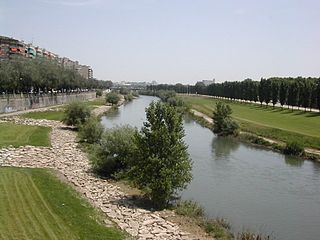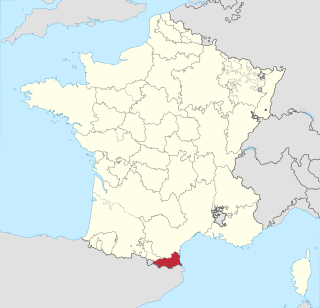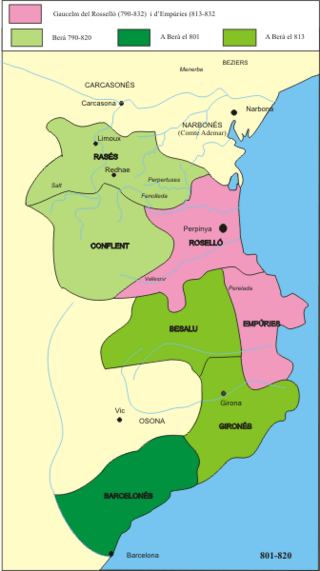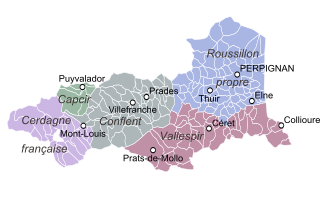
The Segre is a river tributary to the Ebro with a basin comprising territories across three states: France, Andorra, and Spain.

Puigcerdà is the capital of the Catalan comarca of Cerdanya, in the province of Girona, Catalonia, northern Spain, near the Segre River and on the border with France.

Llívia is a town in the comarca of Cerdanya, province of Girona, Catalonia, Spain. It is a Spanish exclave surrounded by the French département of Pyrénées-Orientales.

Roussillon was a historical province of France that largely corresponded to the County of Roussillon and part of the County of Cerdagne of the former Principality of Catalonia. It is part of the region of Northern Catalonia or French Catalonia, corresponding roughly to the present-day southern French département of Pyrénées-Orientales in the former region of Languedoc-Roussillon.

The Treaty of the Pyrenees was signed on 7 November 1659 and ended the Franco-Spanish War that had begun in 1635.

Cerdanya is a comarca in northern Catalonia, in the Pyrenees, on the border of Catalonia with France and Andorra. Within Catalonia, Cerdanya is divided between Catalan provinces of Girona and Lleida. Cerdanya's neighbouring comarques are Alt Urgell, Berguedà, and Ripollès.

The Pyrénées-Orientales department is composed of 226 communes.

French Cerdagne is the northern half of Cerdanya, which came under French control as a result of the Treaty of the Pyrenees in 1659, while the southern half remained in Spain. Catalans often refer to French Cerdagne as Upper Cerdanya. It is the only French territory on the Iberian Peninsula, as it is located on the south side of the Pyrenees Range between France and Spain. For example, the Segre river, which goes west and then south to meet the Ebro, has its source in the French Cerdagne. An inadvertent result of the Treaty of the Pyrenees is the Spanish exclave of Llívia which is sovereign Spanish territory surrounded by French Cerdagne.

Northern Catalonia, North Catalonia or French Catalonia is the formerly Catalan-speaking and cultural territory ceded to France by Spain through the signing of the Treaty of the Pyrenees in 1659 in exchange of France's effective renunciation on the formal protection that it had given to the recently founded Catalan Republic. The area corresponds roughly to the modern French département of the Pyrénées-Orientales which were historically part of Catalonia since the old County of Barcelona, and lasted during the times of the Crown of Aragon and the Principality of Catalonia until they were given to France by Spain.

Font-Romeu-Odeillo-Via, or simply Odeillo, is a commune in the Pyrénées-Orientales and Cerdagne near the Spanish border in the south of France. It comprises the villages of Odeillo and Via, as well as Font-Romeu, one of the oldest ski resorts in France and the oldest in the Pyrenees.

Villefranche-de-Conflent is historically a town in the Conflent region of Catalonia, and now a commune in the Pyrénées-Orientales department in southern France. It is a member of Les Plus Beaux Villages de France Association.

The County of Roussillon was one of the Catalan counties in the Marca Hispanica during the Middle Ages. The rulers of the county were the counts of Roussillon, whose interests lay both north and south of the Pyrenees.

Bourg-Madame is a commune in the Pyrénées-Orientales department in southern France.

The County of Cerdanya was one of the Catalan counties formed in the last decades of the 8th century by the Franks in the Marca Hispanica. The original Cerdanya consisted of the valley of the upper Segre. Today Cerdanya is a Catalan comarca.

The County of Conflent or Confluent was one of the Catalan counties of the Marca Hispanica in the ninth century. Usually associated with the County of Cerdanya and the county of Razès, it was located to the west of Roussillon. It largely corresponded to the modern comarca of Conflent.

Pyrénées-Orientales, also known as Northern Catalonia, are a department of the region of Occitania, Southern France, adjacent to the northern Spanish frontier and the Mediterranean Sea. It borders the departments of Ariège to the northwest and Aude to the north, the Mediterranean Sea to the east and the Spanish province of Girona in Catalonia to the south and the country of Andorra to the west. It also surrounds the tiny Spanish exclave of Llívia, and thus has two distinct borders with Spain. In 2019, it had a population of 479,979. Some parts of the Pyrénées-Orientales are part of the Iberian Peninsula. It is named after the Pyrenees mountain range.

Occitania is the southernmost administrative region of metropolitan France excluding Corsica, created on 1 January 2016 from the former regions of Languedoc-Roussillon and Midi-Pyrénées. The Council of State approved Occitania as the new name of the region on 28 September 2016, coming into effect on 30 September 2016.

The Angelets, or “the Angelets of the Land”, were peasants who rose up in peasant revolts from 1667 to 1675 against the French authorities in Roussillon; the group of conflicts of the period is called the Revolt of the Angelets. The cause was the institution of the gabelle, a tax on salt, in 1661—a measure contrary to traditional constitutions of the earldom. The revolt first concerned the county of Vallespir, then it spread to those of Conflent and Roussillon.
The canton of Les Pyrénées catalanes is an administrative division of the Pyrénées-Orientales department, in Southern France. It was created at the French canton reorganisation which came into effect in March 2015. Its seat is in Prades.

Northern Catalonia is traditionally divided into five historical comarques (counties). These counties formed part of the Principality of Catalonia until the territory was incorporated into France following the Treaty of the Pyrenees, with Cerdanya county split between Spain and France. After the French Revolution, the current department of Pyrénées-Orientales was created, comprising the Northern Catalan counties along with part of the Occitan parçan of Fenouillèdes (Fenolhedés).

























